Explosive Materials Example
Chemistry / / July 04, 2021
Is named Explosive Material to any chemical substance that when in contact with a high amount of heat or a spark, presents a reaction with rapid and excessive energy release and an invasion of the surrounding volume, to the degree of being dangerous and destructive. This reaction that is talked about is called Explosion.
To better understand the chemical behavior of explosive materials, the concepts of Activation energy, which is a chemical property of matter; and of Fulminant, an important agent in the development of a reaction.
Activation energy: It is the minimum energy that requires a reaction to begin to happen and to advance naturally. When the Activation Energy is very high, it is generally resorted to Catalysts, which are chemicals that are more easily activated, and can thus provide the energy to approach the main reaction. When it comes to controlled explosions, caps are used, which are the type of catalyst characteristic of explosions.
Fulminant: It is the substance that serves to
chemically incite the explosion in an explosive material. The primer is also an explosive material, but with activation energy much lower than that of the main explosive material. It can be Potassium Nitrate (KNO3), Mercury Fulminate [Hg (CNO)2].Storage of explosive materials
Explosive materials, so that there is no danger, should always be stored in a ventilated, cool and dry area. The freshness is to get away from the risk temperature, and the lack of humidity so that the material does not spoil. And, of course, the explosive materials warehouse must be away from all human settlements, in case the remote contingency of a massive outbreak occurs.

Marking of explosive materials
All hazardous materials are identified in the industrial environment, based on the Official Mexican Standards that involve signage for a better and safer environment within the company.
The marking used for hazardous materials is called Pictogram, which is a simple black image with an orange background.

Applications of explosive materials
Explosive materials are widely used in the Mining, for mineral extraction in rock formations. It begins by calculating the strategic sites that will give the best explosion to extract the greatest amount of rocky material.
Are made deep but narrow holes on the huge rock to place the charge of explosive material, at the calculated points. Subsequently the appropriate amount of explosive substance is added. When everything is ready the area is cleared of all human presence, and at a distance the explosion is caused; The Result of the explosion, in which the mineral material flies off into smaller, more manageable fragments is called Blasting.

Subsequently, the materials are taken to crushing, and later to grinding to process them and obtain metals or salts of interest.
The most frequently used explosive is TriNitroToluene (TNT), an organic compound made up of a benzene ring, three Nitro groups and a methyl radical.
TriNitroToluene (TNT) comes in a cartridge form with a wick, well known for being represented on TV shows. The holes that are made in the rock where the blasting will be made have just enough space for the placement of the TNT cartridge.

A chemical species, which is the Ammonium Nitrate NH4NOT3, has a main application as a fertilizer, being an abundant source of Nitrogen for soils. However, it is a powerful and dangerous explosive.
With Ammonium Nitrate NH4NOT3 important precautions are taken. When transporting it, for example, it is avoided that it has excessive contact with the sun's heat, since it can catch fire and explode consecutively.
Furthermore, when Ammonium Nitrate NH4NOT3 It is required precisely as an explosive, it is taken care that there is no humidity that could reduce the initiation of the fire that will activate it. If the material gets wet, it will no longer serve as an explosive.

Another explosive material is hydrogen gas, used as a light fuel for some experimental vehicles at the aerospace level, but given the danger of this gas, it was not certain that the vehicles were manned.
The most widely used mixture of explosive components is the Gunpowder, formerly used for load firearms, and now applied both in blasting in the mining sector as in pyrotechnics, neither of which is a harmless activity. It is composed of Carbon (C), Sulfur (S) and Potassium Nitrate (KNO3) mainly.

Examples of Explosive Materials
Ammonium Nitrate NH4NOT3
Potassium Nitrate KNO3
Hydrogen Gas H2
TriNitroToluene (TNT) C7H5N3OR6
Mercury Fulminate Hg (CNO)2
NitroCellulose
Hydrogels
Dynamites
Emulsions
NitroGlycerin and NitroCellulose Blend
Nitrobenzene


